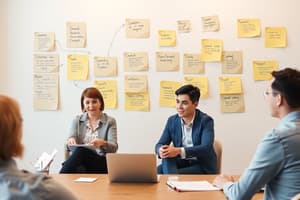Podcast
Questions and Answers
What is the primary purpose of training within an organization?
What is the primary purpose of training within an organization?
- To enhance corporate performance through knowledge and skill development (correct)
- To expand personal interests of employees
- To provide general education to all employees
- To prepare employees for future roles
How does development differ from training?
How does development differ from training?
- Development is done by supervisors, while training is done by educators.
- Development focuses on long-term employee growth, while training is short-term and task-oriented. (correct)
- Development is specific to job-related tasks while training is broad.
- Development is only for managerial roles, whereas training is for all employees.
Which of the following best describes education?
Which of the following best describes education?
- A systematic approach to altering behavior and attitudes
- A short-term engagement focused on specific job skills
- A process closely related to training and development efforts
- A lifelong investment aimed at broadening knowledge for societal benefit (correct)
What is NOT a characteristic of training?
What is NOT a characteristic of training?
In what way is development considered a strategic form of training?
In what way is development considered a strategic form of training?
Which aspect does training specifically NOT emphasize?
Which aspect does training specifically NOT emphasize?
Which statement about the nature of learning is correct?
Which statement about the nature of learning is correct?
What is one of the main objectives of training and development?
What is one of the main objectives of training and development?
What is the primary goal of competence-based training?
What is the primary goal of competence-based training?
Which of the following is not a component of the learning process?
Which of the following is not a component of the learning process?
Which factor is significant in enhancing learning effectiveness?
Which factor is significant in enhancing learning effectiveness?
How does understanding contribute to effective learning?
How does understanding contribute to effective learning?
What is the role of memory in the learning process?
What is the role of memory in the learning process?
Which statement best describes the relationship between knowledge acquisition and learning a language?
Which statement best describes the relationship between knowledge acquisition and learning a language?
All of the following are implications of providing development opportunities, except:
All of the following are implications of providing development opportunities, except:
What best characterizes the dynamic learning process?
What best characterizes the dynamic learning process?
Which approach do some learners prefer when facing new information?
Which approach do some learners prefer when facing new information?
What is a key characteristic of effective learners?
What is a key characteristic of effective learners?
Why is feedback important in the learning process?
Why is feedback important in the learning process?
How should feedback be delivered for it to be most effective?
How should feedback be delivered for it to be most effective?
What should be included in effective feedback?
What should be included in effective feedback?
What sensory modality is best for learners who thrive on physical activity?
What sensory modality is best for learners who thrive on physical activity?
Which of the following is NOT a benefit of ensuring effective feedback?
Which of the following is NOT a benefit of ensuring effective feedback?
What defines true learning according to the content?
What defines true learning according to the content?
Which principle emphasizes the need to engage multiple senses for better learning retention?
Which principle emphasizes the need to engage multiple senses for better learning retention?
What does the learning curve principle suggest about the pace of learning?
What does the learning curve principle suggest about the pace of learning?
Which factor has a significant impact on a student's ability to maintain attention while learning?
Which factor has a significant impact on a student's ability to maintain attention while learning?
What is indicated about memory retention in relation to factual knowledge?
What is indicated about memory retention in relation to factual knowledge?
How can educators best motivate students in their learning?
How can educators best motivate students in their learning?
What percentage of what we teach contributes to our learning according to the sensory engagement principle?
What percentage of what we teach contributes to our learning according to the sensory engagement principle?
Which of the following is NOT a factor influencing learning effectiveness?
Which of the following is NOT a factor influencing learning effectiveness?
What happens to information if it is not reviewed after being learned?
What happens to information if it is not reviewed after being learned?
Which action verb is most appropriate for assessing someone's abilities objectively?
Which action verb is most appropriate for assessing someone's abilities objectively?
Which two verbs relate to the problem-solving process of innovation?
Which two verbs relate to the problem-solving process of innovation?
What action verb would be best to describe the evaluation of learning resources?
What action verb would be best to describe the evaluation of learning resources?
Which action verb focuses on adapting to new situations?
Which action verb focuses on adapting to new situations?
Which verb would be less effective in evaluating a student's performance?
Which verb would be less effective in evaluating a student's performance?
Which method is best for enhancing student engagement during a lesson?
Which method is best for enhancing student engagement during a lesson?
Which action verb is linked to making informed decisions based on gathered information?
Which action verb is linked to making informed decisions based on gathered information?
Which action verb best describes a teacher's role in facilitating student understanding?
Which action verb best describes a teacher's role in facilitating student understanding?
Flashcards are hidden until you start studying
Study Notes
Learning
- Learning is the process of changing behaviors and attitudes.
- Nature versus nurture is a debate about how much of our behavior is innate and how much is learned.
Training
- Training is a methodical process to teach an organization's workforce.
- The goal is to improve on-the-job performance by providing new skills and knowledge through activities and instruction.
Development
- Development is a learning process driven by experience, expanding an individual's attitudes and task abilities.
- It focuses on preparing employees for future roles, broader than the demands of their current jobs.
- Development is considered strategic training as it helps employees grow in their careers.
Education
- Education is the process of broadening someone's or group's knowledge and skills with the aim of benefiting society.
Differences between Training, Development, and Education
- Training: Short-term, focused on specific tasks and job-related skills, aims to change knowledge, attitudes, and abilities.
- Development: Long-term investment in staff, broader than specific tasks, prepares employees for future roles.
- Education: A lifetime investment in self-growth, not necessarily job-related, focuses on general knowledge and societal contribution.
Principles of Learning
- Learning involves gaining knowledge, skills, and attitudes, leading to a change in performance.
- Memory: Key to acquiring and keeping knowledge.
- Understanding: Critical for real-world application of learned information.
Factors Affecting Learning
- Motivation: Essential for effective learning, encourages attention.
- Teacher/Peer Relationships: Can help students succeed.
- Resources and Time: Adequate resources and time are vital for learning.
- Mood and Surroundings: These impact learning and affect focus.
- Prior Knowledge: Influences how easily new information is acquired.
- Teaching method: How information is presented impacts learning.
- Perceived Relevance: Learning is more engaging and effective when perceived as valuable.
Seven Principles of Learning
- Utilize and Stimulate the Senses: Engage multiple senses for improved retention (e.g., 10% of what we read, 90% of what we teach).
- Recognize the Learning Curve: Recognize individual learning rates and that mastery takes time.
- Don't Abuse Attention Span: Attention is vital for learning and can be improved through motivation.
- Encourage Effective Use of Memory: Review information shortly after learning to enhance long-term retention.
- Motivate Learners: Make learning engaging and relevant to motivate learners.
- Accommodate Different Learning Styles: Learners have diverse learning preferences (e.g., visual, auditory, kinesthetic).
- Ensure Effective Feedback: Feedback helps pinpoint areas for improvement, monitor progress, motivate, and strengthen learning.
Problem-Solving
- Requires combining rules and logic to handle complicated challenges.
Teaching and Learning Resources
- Identify resources needed to support learning (e.g., handouts, videos, digital resources).
- Ensure resources align with the chosen teaching methods for maximized effectiveness.
Instructional Methods
- Explanation and Demonstration: Crucial for explaining new topics.
- Interactive Techniques: Questioning, group work, and discussions help engage learners.
- Tips: Align methods with the subject matter and student needs, adapt techniques to match group dynamics and development stages.
Training Area and Resources
- Ensure the training area is suitable for the chosen methods and participants.
- Check seating arrangements, equipment, and resources in advance.
Studying That Suits You
Use AI to generate personalized quizzes and flashcards to suit your learning preferences.




